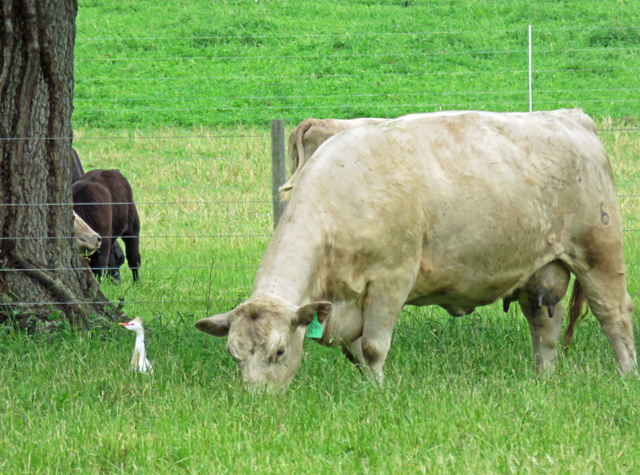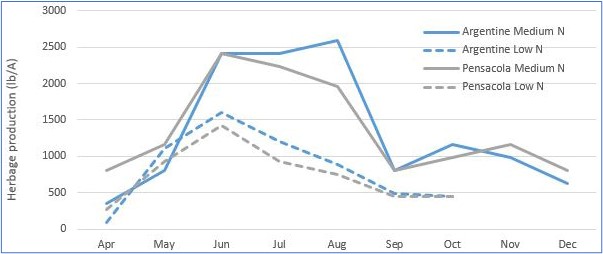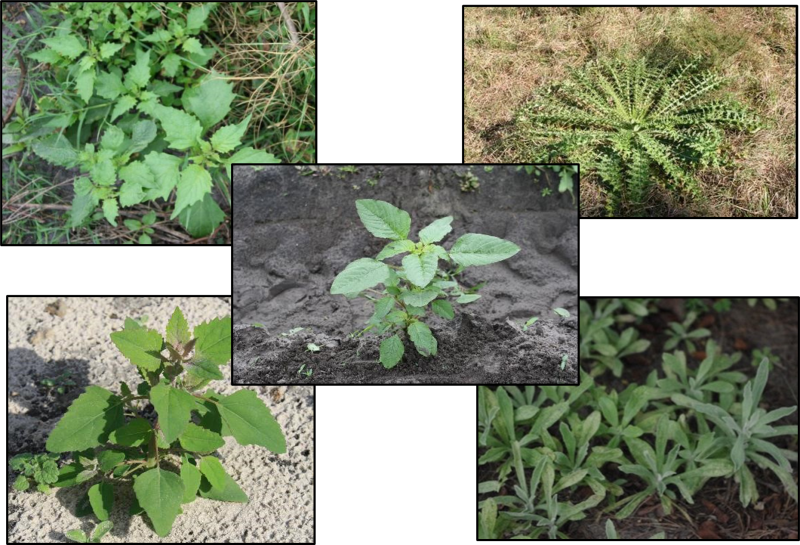
The long summer days with regular rainfall are when bahiagrass grows the fastest and provides the greatest response to nitrogen fertilization. If you need more forage production, this is a good time to fertilize, if you have not already. Credit: Doug Mayo, UF/IFAS
Cheryl Mackowiak, UF/IFAS Forage Soil Scientist, NFREC Quincy
If you need greater grass production, now is the time to maximize your results! Due to our southern grass’ response to long days, we typically achieve the most growth from June through early August. Additionally, nitrogen (N) is the one nutrient that can directly impact potential yield gains in our grass crops during this period (Figure 1).

Figure 1. Herbage production for Argentine (blue lines) and Pensacola (gray lines) bahiagrass under medium (100 lb N/A; solid lines) and low (53 lb N/A; dashed lines) nitrogen fertilization. Credit: Wallau et al., 2019. Bahiagrass: Overview and Pasture Management. SS-AGR-332. University of Florida Institute of Food and Agricultural Sciences.
–
What you need to ask yourself is do you need or want to maximize production, or will you end up with too much of a good thing by applying higher N rates during this period? The following are factors to consider when making that decision:
- Do you have a way to utilize the additional forage production, if you increase your N fertilization rate from 40 to 80 lbs N/acre? Options may include increasing stocking rate or harvesting hay. Overly mature (rank) grass typically has lower quality and palatability and should be avoided, so do not let it sit out there beyond its prime.
– - Is rainfall expected to be adequate (not too little or too much)? If so, then that is in your favor. High (2-inch per hour or over 3 inches per event) may result in nitrogen (as nitrate) fertilizer leaching losses in our sandy, Florida soils. Locations with heavier soils might also encounter nitrogen run-off. On the other hand, if rainfall/soil moisture is significantly low, you might lose urea type fertilizer nitrogen through gaseous nitrogen emissions (volatilization). More concerning under droughty soils, nitrogen will accumulate in the grass as nitrates, which can harm or in extreme cases, kill your livestock. In cattle, nitrates over 3,000 ppm (dry matter) may affect pregnant cows and younger calves, while nitrates over 9,000 ppm is potentially lethal (Gadberry and Jennings, 2023. Nitrate poisoning in cattle. FSA3024. University of Arkansas Extension Services. Accessed 29 June 2023).
– - Organic-based fertilizers (biosolids, poultry litter, composts) are good forms of slow-release nitrogen and phosphorus. Polymer-coated nitrogen products are also valuable. However, if you want to capture the remaining few weeks of maximum production this July, release rates might be too slow to keep up, especially for faster growing grasses, such as bermudagrass. Including a portion (around 50%) of your nitrogen need from conventional mineral N during this period may provide you the best of both worlds (readily available nitrogen now and a little saved for later in the season).
– - Higher nitrogen fertilizer application rates (80+ lbs/acre), particularly if not balanced with adequate potassium and sulfur fertility, may sensitize grasses, particularly bermudagrass and bahiagrass, to various foliar fungal diseases, and occasionally Take-All Root Rot (TARR) disease. Plant growth suppressed by disease pressures under high nitrogen fertility may lead to nitrate accumulation.
–
Our perennial grasses are not the only forages prone to nitrate accumulation. Sorghum, corn, sudangrass and cool-season small grains can, as well. During the summer months several nitrate accumulating weeds can be found in pastures and hay fields. They include nightshade, bull thistle, pigweed, lambsquarters, and cudweed (aka rabbit tobacco) (Figure 2). Cudweed is considered a cool season weed, but it seems to be lasting longer into the summer months than it once did. Although most, if not all, of the listed weed species are typically avoided by cattle, it is not fool-proof and you do not want these weeds in harvested hay. Awareness of your growing conditions, forage condition, and routine (every few weeks) scouting of your pastures and hay fields for weeds and diseases is a wonderful preventative measure for all kinds of potential problems, including nitrate toxicity issues.

Figure 2. Reported nitrate accumulating weeds of Florida. At center, Pigweed (Palmer amaranth); clockwise from upper left: American Black Nightshade; one of several thistle species; cudweed; lambsquarters. Image credits: pigweed and lambsquarters from Byron et al. 2023 HS1335.; nightshade from RCREC online Weed Identification Tool; thistle from Sellers et al. 2022 SS-AGR-95. https://edis.ifas.ufl.edu/publication/AG253 ; cudweed from MFREC online Weed Species ID Guide. 2023
- 2025 Cool-Season Forage Tour – February 26 - February 14, 2025
- Florida Soils are an Indispensable Natural Resource - January 10, 2025
- Regenerative Agriculture: What it Means to You - June 21, 2024
